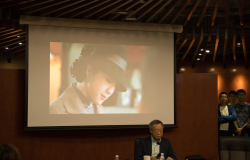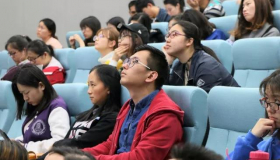Diligentia et Sapientia | Movie and Literature, History and Arts
<p style="text-align: justify;">The 5<sup>th</sup> Diligentia et Sapientia marks the first Diligentia et Sapientia in this semester. We are honored to have Prof. Li Oufan, the first speaker in Diligentia et Sapientia series of lectures. Prof. Li had talked about literature, city/history and shared his stories before, this time, he would like to talk about movie and the relationship between movie and literature. Prof. Lee said, “There are two cultures, writing culture and visual culture. After thousands years, word-oriented writing culture is now challenged by image-based visual culture. Movie became the most popular media and we entered a digital visual media era driven by technology innovation.”</p>
<p style="background: white; margin: 0cm 0cm 0pt; text-align: center; line-height: 19.2pt;"> </p>
<p style="background: white; margin: 0cm 0cm 0pt; text-align: center; line-height: 19.2pt;"><img alt="" src="/sites/default/files/imce/user/791/img_7725_0.jpg" style="width: 640px; height: 427px;" /></p>
<p> </p>
<p align="center"><span style="font-size:14px;"><strong class="drupal-bold">Evolution</strong></span></p>
<p style="text-align: justify;">To understand the relationship between movie and literature, we should go through western, eastern culture evolutions, mime art era in western film and Shanghai modern times. The 20<sup>th</sup> century is one of the most important turning points in Chinese culture --- there were unstoppable waves after the May Fourth Movement: litterateurs were mushrooming with their novels. While novel, a representative form writing culture, was gaining popularity among authors as an effective way to spared ideas.It was the same important period for the movie. Thanks to technology innovations, the movie was popularized in public. We could tell a lively story through pictures and acting, in which everyone, regardless his or her educational background, could have their own opinions on the story. We supposed movie would also play a significant role in getting ideas around as novel. While there were limited authors mentioned the movie in their writings. Moreover, few authors took part in writing movies. Xia Yan is an exception and Eileen Zhang is a representative of those exceptions.</p>
<p> </p>
<p align="center"><img alt="" src="/sites/default/files/imce/user/791/img_7769.jpg" style="width: 640px; height: 427px;" /></p>
<p style="text-align: justify;">In the 1940s, the theatre was a trendy alone with urbanization in China. We could find the footage-like description of Eileen’s works. Later, members of Mandarin Duck and Butterfly School introduced western films to China, raised movie’s art value shortly, separated it from vaudeville and transferred it to a fashion among refined scholarsProf. Lee mentioned many interesting facts in reviewing the development of literature and movie. An example of visual media’s influence: Lu Xun was very fond of the movie, scholars believed, to some extent, Mr. Lu’s transformation from a medical student to a litterateur was impacted by power point. However, Mr. Lu did not write much about the movie. Because in literary traditions, writing culture, represent by novel most time, dominated culture and many litterateurs had this mindset.</p>
<p style="text-align: justify;"> </p>
<p style="font: 14px/22.4px "Helvetica Neue",Helvetica,"Hiragino Sans GB","Microsoft YaHei",Arial,sans-serif; margin: 0px; padding: 0px; text-align: center; color: rgb(62, 62, 62); text-transform: none; text-indent: 0em; letter-spacing: normal; clear: both; word-spacing: 0px; white-space: normal; word-wrap: break-word !important; min-height: 1em; max-width: 100%; box-sizing: border-box; widows: 1; -webkit-text-stroke-width: 0px; background-color: rgb(255, 255, 255);"><img alt="" src="/sites/default/files/imce/user/791/img_7506.jpg" style="width: 640px; height: 427px;" /></p>
<p style="margin: 0px; padding: 0px; max-width: 100%; box-sizing: border-box; word-wrap: break-word !important; clear: both; min-height: 1em; color: rgb(62, 62, 62); font-family: 'Helvetica Neue', Helvetica, 'Hiragino Sans GB', 'Microsoft YaHei', Arial, sans-serif; font-size: 14px; font-style: normal; font-variant: normal; font-weight: normal; letter-spacing: normal; line-height: 22.3999996185303px; orphans: auto; text-align: justify; text-indent: 0em; text-transform: none; white-space: normal; widows: 1; word-spacing: 0px; -webkit-text-stroke-width: 0px; background-color: rgb(255, 255, 255);"> </p>
<p style="text-align: justify;">New cultures would strive their way towards dominant cultures. At that time, we could not tell the impact of visual culture on writing culture, while it was obvious writing culture had “invaded” in films --- in the middle of 20th century, many classics were adapted into films. One character of these movies is dialogue dominance--- movie was too attached to the text. Adapted films from Xia Yan’s writings are examples. Prof. Lee thought, in that condition, these directors did not understand the art of movie, they just take the movie as another form of writing culture, and researchers about the movie were based on novel’s perspective. In other countries, with the development of movie technic and vision, movie was no longer a narrative method, but an imagery art. Especially after the invention of montage, film editing emphasized on light and shadow layout, cosmic synchronization, then connected with surrealism, that made movie the “7<sup>th</sup> arts” in line with literature, painting and sculpture.</p>
<p> </p>
<p style="text-align: justify;">One famous comment about movie said: movie is played in theatre to a bunch of audience, so movie is a “copy” of artwork. Walter Benjamin, a German philosopher and literary critic, thought copy would deprive the originality of an artwork, while it meets public’s demand: fanciness and excitement. Movie, as a public media, possess a set of rule that distinct to traditional arts. In Prof. Lee’s view, the commentator did not know much about the movie when he wrote these words. Even though he espied the untapped potential and limitation of movie, he failed to define the relationship between movie, writing culture and “artwork”.</p>
<p style="margin: 0px; padding: 0px; max-width: 100%; box-sizing: border-box; word-wrap: break-word !important; clear: both; min-height: 1em; color: rgb(62, 62, 62); font-family: 'Hiragino Sans GB', 'Microsoft YaHei', Arial, sans-serif; font-size: 14px; font-style: normal; font-variant: normal; font-weight: normal; letter-spacing: normal; line-height: 22.3999996185303px; orphans: auto; text-align: justify; text-indent: 0em; text-transform: none; white-space: normal; widows: 1; word-spacing: 0px; -webkit-text-stroke-width: 0px; background-color: rgb(255, 255, 255);"> </p>
<p align="center"><strong class="drupal-bold">Intersection </strong></p>
<p style="text-align: justify;">The adapted film is a vital intersection between writing and visual culture. According to Prof. Lee, the adapted film is trying to connect two cultures. The novel is the most familiar form in writing culture, likes the movie, they are both about story-telling. Telling a plain story is the baseline, a director should break timelines, spaces, characters, backgrounds and languages in writings, reproduce these components with his magic and creativity to tell a fantastic story in the movie. In other words, the one who played wildcards with the adapted film may have an unexpected outcome.</p>
<p style="text-align: justify;">The 4<sup>th</sup> part of <em class="drupal-italic">Six Lectures in Humanity</em>, by Prof. Lee, said the movie is not just about entertainment, good movies are intertwined with culture. Adapted classical literature to the movie would leave the audience a deeper impression. Not every classical movie is adapted from literature, but they play similar roles. As Calvino said: every time you read a classic, you will find something new, just like the first time. In my opinion, literature, movie and music could fill up our spare time in daily lives, dealing with pressure brought by fast-paced lifestyle. </p>
<p style="text-align: justify;"> </p>
<p style="text-align: center;"><img alt="" src="/sites/default/files/imce/user/791/img_7818.jpg" style="width: 640px; height: 427px;" /></p>
<p style="text-align: justify;">Even literature is incomparable in the narrative, as it gives readers more space for imagination, the movie could create the sense of reality through scenes. An outstanding director could show the fantasy imaginary scenes with his magic, while he could hardly break the limitation of narrative in the movie, not mentioned to the limitation of language. There are angles of view and voice-over in the movie, but they cannot describe subjective exquisite emotions exactly as words. For the adapted film, directors might only “counterpoint” the ideas, outcomes and narrative to a film, to “echo” the words in the novel.</p>
<p style="margin: 0px; padding: 0px; max-width: 100%; box-sizing: border-box; word-wrap: break-word !important; clear: both; min-height: 1em; color: rgb(62, 62, 62); font-family: 'Hiragino Sans GB', 'Microsoft YaHei', Arial, sans-serif; font-size: 14px; font-style: normal; font-variant: normal; font-weight: normal; letter-spacing: normal; line-height: 22.3999996185303px; orphans: auto; text-align: justify; text-indent: 0em; text-transform: none; white-space: normal; widows: 1; word-spacing: 0px; -webkit-text-stroke-width: 0px; background-color: rgb(255, 255, 255);"> </p>
<p style="margin: 0px; padding: 0px; max-width: 100%; box-sizing: border-box; word-wrap: break-word !important; clear: both; min-height: 1em; color: rgb(62, 62, 62); font-family: 'Hiragino Sans GB', 'Microsoft YaHei', Arial, sans-serif; font-size: 14px; font-style: normal; font-variant: normal; font-weight: normal; letter-spacing: normal; line-height: 22.3999996185303px; orphans: auto; text-align: justify; text-indent: 0em; text-transform: none; white-space: normal; widows: 1; word-spacing: 0px; -webkit-text-stroke-width: 0px; background-color: rgb(255, 255, 255);"> </p>
<p style="margin: 0px; padding: 0px; max-width: 100%; box-sizing: border-box; word-wrap: break-word !important; clear: both; min-height: 1em; color: rgb(62, 62, 62); font-family: 'Hiragino Sans GB', 'Microsoft YaHei', Arial, sans-serif; font-size: 14px; font-style: normal; font-variant: normal; font-weight: normal; letter-spacing: normal; line-height: 22.3999996185303px; orphans: auto; text-align: justify; text-indent: 0em; text-transform: none; white-space: normal; widows: 1; word-spacing: 0px; -webkit-text-stroke-width: 0px; background-color: rgb(255, 255, 255);"> </p>
<p align="center"><strong class="drupal-bold">Imbroglio </strong></p>
<p style="text-align: justify;">Nowadays, it is obvious that visual culture impacted writing culture significantly---not only more people like the movie, a lively story-telling way, in which you could come across different times and spaces in visual artworks but also visual culture influenced novel-writing. It takes loads of paragraphs to describe a scene while it just cost several pictures in the movie and you could recreate the same scene in different ways with various film expression techniques. </p>
<p style="text-align: center;"><img alt="" src="/sites/default/files/imce/user/791/img_7657.jpg" style="width: 640px; height: 427px;" /></p>
<p style="text-align: justify;">Prof. Lee shared some movie clips and texts to compare these two arts: <em class="drupal-italic">Lust, Caution, The Golden Era, Jane Eyre</em>, and two versions of <em class="drupal-italic">Anna Karenina</em>. Two or three decades ago, more people preferred literature, they thought the adapted film cannot reproduce classic. Now we are in a visual era, there is growing number of people believe we should not view the movie with literature standards. But for literature adapted films, should we abandon all literature standard? Prof. Lee, a fan of both movie and literature, understands these difficulties in adapting. “A movie could only demonstrate parallel ideas in novel, or ‘counterpoint’ the time-space relationships and narrative. That is also the difficulties in adapting the stream-of-consciousness novel. The movie cannot rearrange time and space in a novel, and language process, lights and shots could also mismatch expressions. </p>
<p style="text-align: center;"><img alt="" src="/sites/default/files/imce/user/791/img_7662.jpg" style="width: 640px; height: 427px;" /></p>
<p style="text-align: justify;">Finally, in the Q&A session, Prof. Lee answered every question from the popular movie to art film, just like sharing his research and hobbies with friends. The insightful lecture ended with enjoyable interactions. Movie and novel, or any kind of culture, boast their unique characteristics. The successful combination of cultures could shake the literature world. No matter in what form, the classic could always touch our hearts, bringing reflections and inspirations to our life.</p>
<p style="font: 14px/22.4px "Hiragino Sans GB","Microsoft YaHei",Arial,sans-serif; margin: 0px; padding: 0px; text-align: center; color: rgb(62, 62, 62); text-transform: none; text-indent: 0em; letter-spacing: normal; clear: both; word-spacing: 0px; white-space: normal; word-wrap: break-word !important; min-height: 1em; max-width: 100%; box-sizing: border-box; widows: 1; -webkit-text-stroke-width: 0px; background-color: rgb(255, 255, 255);"> </p>
<p style="font: 14px/22.4px "Hiragino Sans GB","Microsoft YaHei",Arial,sans-serif; margin: 0px; padding: 0px; text-align: center; color: rgb(62, 62, 62); text-transform: none; text-indent: 0em; letter-spacing: normal; clear: both; word-spacing: 0px; white-space: normal; word-wrap: break-word !important; min-height: 1em; max-width: 100%; box-sizing: border-box; widows: 1; -webkit-text-stroke-width: 0px; background-color: rgb(255, 255, 255);"><img alt="" src="/sites/default/files/imce/user/791/img_7743.jpg" style="width: 640px; height: 427px;" /></p>
<p style="margin: 0px; padding: 0px; max-width: 100%; box-sizing: border-box; word-wrap: break-word !important; clear: both; min-height: 1em; color: rgb(62, 62, 62); font-family: 'Hiragino Sans GB', 'Microsoft YaHei', Arial, sans-serif; font-size: 14px; font-style: normal; font-variant: normal; font-weight: normal; letter-spacing: normal; line-height: 22.3999996185303px; orphans: auto; text-align: justify; text-indent: 0em; text-transform: none; white-space: normal; widows: 1; word-spacing: 0px; -webkit-text-stroke-width: 0px; background-color: rgb(255, 255, 255);"> </p>
<p align="center"><strong class="drupal-bold">Comments </strong></p>
<p align="right"> </p>
<p style="text-align: justify;">Who will be experts and pioneers in the future literature and movie (art)? Thanks to Prof. Lee for taking us through hundreds of years, revealing the development of movie, novel and their influence on each other. With the movie, classic writings could spread ideas in visual version, and movie broke the limitation of words, even redefined expression rules. Taking recent science fiction movies for example: <em class="drupal-italic">Interstellar, </em>directed by Christopher Nolan, reintroduced some abstract concepts like the black hole, time dimensions with images. <em class="drupal-italic">Valerian and the City of a Thousand Planets, </em>directed by Luc Besson, a commercial romance film that also concerns about our future. The movie depicts division of labor, communication and complementarity in a universe, in which human and other races lived together. The movie had broken limitations of literature, then how about the future of literature? From my point of view, the irreplaceable strength of literature lies in imagination, because the most beautiful version of stories is our imagination.</p>
<p align="right">----Wang Le (Presenter on FM 97.1, Shenzhen Media Group, commentator in Phoenix Chinese Channel)</p>
<p> </p>
<p style="text-align: justify;">I really appreciate Diligentia College for inviting Prof. Lee. As a bigoted purist to literature, music and other independent arts, I always reserve my opinion about the movie, the visual-based new art. Because I believe depicting conflict directly would ruin the valuable blank space in artworks. While I changed my mind to the movie after this lecture, in which Prof. Lee dissected classical films from the plot, framework, shot and score. The movie is not limited in the narrative as writings, it broke limitations to express emotions, exploited a field connected aesthetics and speculative philosophy, now the movie is an art as the classic. We should learn to appreciate these new arts. Last, thanks again to Diligentia et Sapientia, I would like to take this chance, taking time to enjoy classical movies in near future, enjoying the gifts of our era.</p>
<p align="right">---- Peng Yunzhu (HSS, Diligentia) </p>
<p> </p>
<p style="text-align: justify;">“What a master Prof. Lee is!” After the lecture, I was filled with admiration to Prof. Lee, for his profound knowledge and incisive literary criticism. He knows everything about the development of novel and movie. We watched clips from<em class="drupal-italic"> Lust, Caution, Anna Karenina</em> and other movies to analysis the pros and cons of movie and novel. It was a regret that I did not make his lectures last semester. Thanks to Diligentia College for inviting Prof. Li again.</p>
<p align="right">---- Zhou Hailin (HSS, Diligentia College)</p>
<p> </p>
<p style="text-align: justify;">Last time I saw Prof. Lee in a movie class in CUHK, he was hale and hearty, full of passion, left me the deep impression as a knowledgeable scholar. Now I meet him again in Diligentia et Sapientia. He changed nothing at all, talking movie and literature logically. Prof. Lee regards himself an old-fashion humanist, while I prefer to call him an erudite ---- you could learn something from everything he speaks. </p>
<p style="text-align: justify;"> </p>
<ul>
<li align="right">Kitty(UPCO staff)</li>
</ul>
<p align="right"> </p>
<p style="margin: 0px; padding: 0px; max-width: 100%; box-sizing: border-box; word-wrap: break-word !important; clear: both; min-height: 1em; color: rgb(62, 62, 62); font-family: 'Hiragino Sans GB', 'Microsoft YaHei', Arial, sans-serif; font-size: 14px; font-style: normal; font-variant: normal; font-weight: normal; letter-spacing: normal; line-height: 22.3999996185303px; orphans: auto; text-indent: 0px; text-transform: none; white-space: normal; widows: 1; word-spacing: 0px; -webkit-text-stroke-width: 0px; text-align: right; background-color: rgb(255, 255, 255);"> </p>












